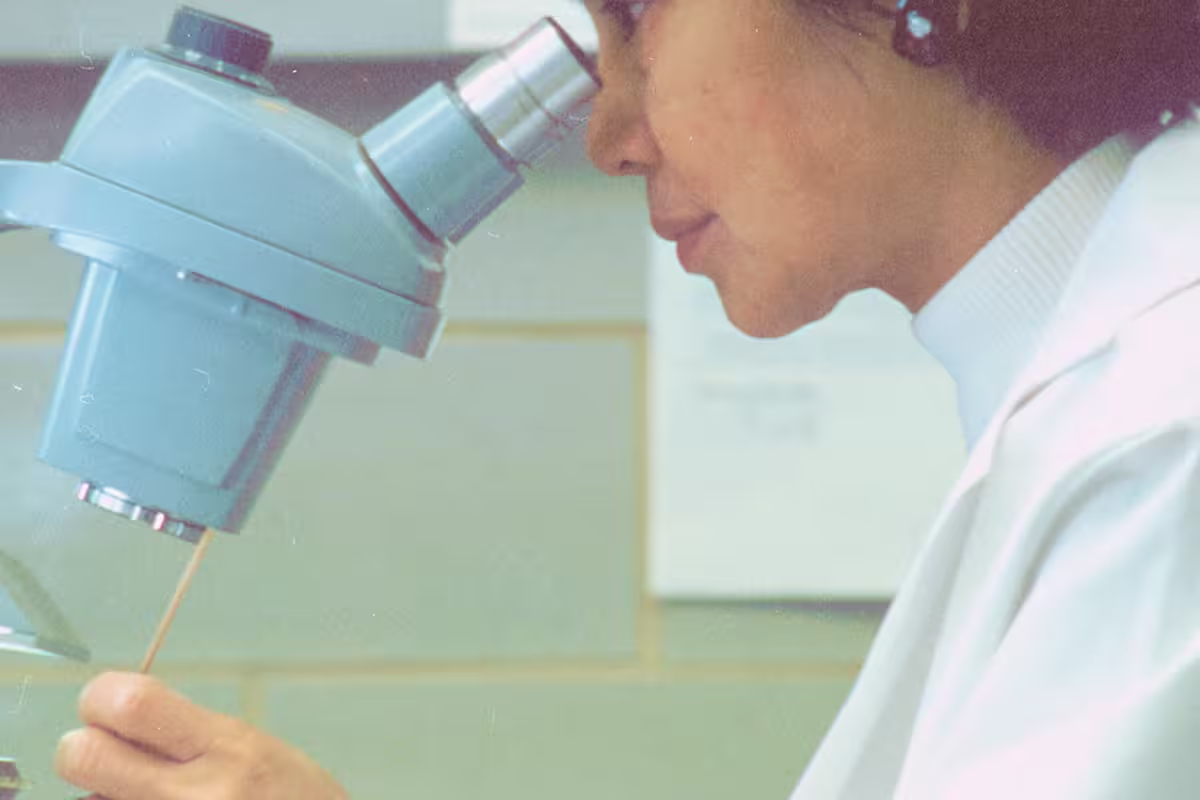

What Are Community State Types?
Community state types explain the different categories of vaginal microbiomes. Learn about the 5 general CSTs and what they mean for you.
Words by Olivia Cassano
Scientifically edited by Dr. Krystal Thomas-White, PhD
Medically reviewed by Dr. Sabrina Sahni, MD NCMP
While every vaginal microbiome is unique, research has shown that most vaginal microbiomes fall into one of five general categories, sometimes called "Community State Types” (CSTs).
While research on the types is evolving, vaginal microbiome community state types can be a helpful way to get a sense of your vaginal microbiome’s composition, what symptoms you may experience, and your risk of developing an infection, such as bacterial vaginosis (BV) or aerobic vaginitis (AV).
The main difference between vaginal microbiome community state types is the species and amount of Lactobacillus, a type of bacteria that plays a critical role in the vaginal microbiome. Lactobacilli keep your vaginal microbiome healthy in a few different ways:
- They produce lactic acid that helps keep the vaginal pH low and healthy (ideally between 3.8 and 4.5)
- They take up space on the vaginal wall, preventing other pathogens from thriving
- They produce bacteriocins, which are your body’s own antibiotics
- They keep inflammation down in the genital tract.
The vaginal microbiome community state types
Each vaginal microbiome community state type is characterized by the type and amount of Lactobacillus present. At a high level each type is characterized by the following bacteria being dominant:

That said, as you will see below, there are many subtypes within these communities, and results at the individual level vary even further. Let’s have a look at the different vaginal microbiome community state types in more detail.
Type 1
Type 1 is considered the healthiest type, since research has shown that it is the most successful at preventing infections like bacterial vaginosis, sexually transmitted infections (STIs), and urinary tract infections (UTIs). This type is also shown to have the lowest risk for other health complications, like infertility, preterm birth, toxic shock syndrome (TSS), and more.
The key bacteria in Type 1 is Lactobacillus crispatus, which comes with all of the aforementioned benefits of Lactobacilli, and has a unique ability to produce a high amount of both types of lactic acid (L- and D-lactic acid). Both types are protective, but D-lactic acid ensures that Type 1 vaginal microbiomes maintain an acidic environment (with a pH lower than 4.5) and can successfully prevent pathogens from taking over.
Within Type 1 there are two subtypes, Type 1-A and Type 1-B. The only noticeable difference between the two is that Type 1-A has a higher percentage of L. crispatus than Type 1-B. While having more L. crispatus is likely more beneficial, both of these results are highly protective.
Type 2
Type 2 is also deemed to be a healthy vaginal community state type, dominated by Lactobacillus gasseri.
Similar to L. crispatus, L. gasseri also produces D-lactic acid, but research has shown that it produces slightly less than L. crispatus. This means L. gasseri might not be as protective as L. crispatus.
Regardless, research shows that Type 2 vaginas have a strong defense against pathogens and a decreased risk of developing infections like bacterial vaginosis, UTIs, and sexually transmitted infections. Type 2 has also been linked with a lower risk of other health conditions, such as infertility, pelvic inflammatory disease, neonatal issues, TSS, and more.

Recurrent symptoms? Get Evvy's at-home vaginal microbiome test, designed by leading OB-GYNs.
Type 3
Type 3 is dominated by a versatile Lactobacillus species called Lactobacillus iners.
While lactobacilli dominance is typically what you want to see in your vaginal microbiome, L. iners can coexist with both healthy and disruptive bacteria, making the microbiome more likely to shift in and out of a healthy state.
If it’s found in the microbiome alongside different disruptive bacteria, it can cause symptoms like itching and abnormal discharge. Alternatively, if L. iners is found in combination with other protective lactobacilli, it seems to act neutral or even protective.
L. iners offers some protection by taking up space on the vaginal wall and producing L-lactic acid, both of which help limit the growth of pathogens. The L-lactic acid helps keep the pH in the vagina low and healthy. However, L-lactic acid is less effective than other vaginal lactic acids at maintaining an acidic environment, so a higher number of L. iners are required in order to maintain a healthy vaginal pH balance.
Some research has also found that L. iners is less protective against sexually transmitted infections and pregnancy complications compared to other Lactobacillus species.
There are two subtypes for Type 3: 3-A and 3-B. The only noticeable difference between the two is that Type 3-A has a higher percentage of L. iners than Type 3-B. The research to date hasn’t shown that either of these is necessarily more protective than the other, given the versatile nature of L. iners. Rather, it’s important to consider the other bacteria present (are they protective vs. disruptive?) and someone’s symptoms when assessing the health of a Type 3 result.
Type 4
Type 4 is characterized by a low abundance of lactobacilli and a high diversity of other bacteria. This community state type can be associated with vaginal dysbiosis and a less stable vaginal environment, which can make you more prone to recurrent infections. Studies have found that a high microbial diversity may increase someone’s risk of adverse health outcomes such as pregnancy complications, STI acquisition, and pelvic inflammatory disease.
Having a Type 4 result may be cause for consideration — and potentially care — but not concern. The vaginal microbiome changes often and can be influenced by anything from medication and supplements, to lifestyle behaviors and more.
Also, not all Type 4 communities are harmful. Many women are Type 4 and asymptomatic, and some women can be Type 4 and colonized by a protective bacterium called Bifidobacterium.
It is important to note that not all vaginas characterized as Type 4 are made up of the same bacterial communities! Type 4 has been divided into three subtypes based on the presence of different proportions of specific bacteria:
Subtype 4A is characterized by a high to moderate proportion of Gardnerella vaginalis and BVAB-1. This result can be associated with bacterial vaginosis, and the presence of BVAB-1 may play a role in the recurrence of bacterial vaginosis.
Subtype 4B is characterized by a high to moderate proportion of Atopobium vaginae and Gardnerella vaginalis. A. vaginae can team up with G. vaginalis to form biofilms which have been implicated in bacterial vaginosis. One theory for why bacterial vaginosis is so hard to get rid of is because of biofilm formation.
Subtype 4C has been further divided into five subtypes:
- Type 4-C0: The most diverse community type, but Prevotella is often present. Prevotella can also form biofilms and is another organism often associated with bacterial vaginosis.
- Type 4-C1: Streptococcus is present, which is a common bacteria in the vaginal microbiome. Whether or not it plays a protective or disruptive role remains undetermined. This depends on the species of Streptococcus and the time of your life (ex. a risk during pregnancy). Streptococcus can produce L-lactic acid (which normally keeps the vaginal pH low and healthy), but it has also been implicated in UTIs and aerobic vaginitis.
- Type 4-C2: Enterococcus is present, which is a normal member of your gut microbiome, but also may play a role in infections like aerobic vaginitis and UTIs.
- Type 4-C3: Bifidobacterium is dominant, which research has shown is a protective bacteria for the vaginal environment (it is a common probiotic ingredient!). Bifidobacterium produces L-lactic acid, which helps keep the vaginal pH low and healthy. However, Bifidobacterium doesn’t produce as much lactic acid as L. crispatus or L. gasseri, so it may offer slightly less protection against vaginal infections than those Lactobacillus species.
- Type 4-C4: Staphylococcus is often present, which research has shown may be associated with aerobic vaginitis and UTIs.
Is a Type 4 result always unhealthy?
Most of the research has not accounted for subtypes within Type 4, but rather grouped them together, allowing the disruptive results to overshadow any other compositions that may be more nuanced, or even healthy. Moreover, given the racial differences among types (Black and Hispanic women are much more likely to be a Type 4) we are hesitant to keep things this simplistic as claiming Type 4 is a concerning result.
Although vaginal Lactobacilli dominance is a sign of what research knows to be “normal and healthy,” we believe there is insufficient research to assume the opposite — low numbers of vaginal Lactobacilli are directly equated to “unhealthy”.
For this reason, we want to empower individuals with all the information. There are currently risks associated with this type, but there is probably more to the story (which we intend to uncover with our data over time).
Type 5
Type 5 is deemed to be a healthy vaginal community state type, dominated by Lactobacillus jensenii.
L. jensenii creates a protective and stable environment by taking up space on the vaginal wall and producing antimicrobial bacteriocins. Similar to L. crispatus, L. jensenii also produces D-lactic acid.
Although L. jensenii is quite rare, it is associated as one of the healthiest dominant species. Interestingly, it has been observed in less than 10% of vaginas in clinical research studies to date.
Research shows this to be one of the most protective types in preventing infections like bacterial vaginosis, sexually transmitted infections, and UTIs. Subsequently, Type 5 is also linked with a very low risk for health issues such as infertility, pelvic inflammatory disease, toxic shock syndrome, and more.
Why are vaginal community state types important?
While knowing your vaginal microbiome type is incredibly helpful information for understanding your health risks, it is also in constant flux. Unlike genetic results — which are static — vaginal microbiomes are dynamic.
There are multiple reasons that the vaginal microbiome changes over time. Your day-to-day behaviors — trying new birth control, medications, supplements, sexual partners, smoking, or vaginal products — can influence its composition. The vaginal microbiome is also affected by changes across your life, shifting alongside hormonal changes such as getting your first period, becoming pregnant, entering postpartum, and being in menopause.
When it comes to the vaginal microbiome, knowledge is power. By keeping tabs on its composition, you can catch potential imbalances early, giving you the chance to proactively take action to promote the beneficial bacteria and prevent the disruptive vaginal bacteria from taking hold.
How to test for your community state type
Curious about what community state type you fall in to, and how it affects your vaginal health? The Evvy Vaginal Health Test can reveal your classification as well as your entire microbial composition, empowering you to know what’s up down there.
All Evvy tests come with a custom plan of clear next steps and a 1:1 call with a certified health coach who can walk you through your results and plan. Also, if eligible, we can connect you with an Evvy-affiliated provider who will review your results and health history and design a custom prescription treatment program just for you.
FAQ
What are community state types?
The vaginal microbiome community state types (CSTs) classify the vaginal microbiota based on the dominant bacterial species present, helping us understand the different kinds of bacteria in the vagina. CST I, dominated by Lactobacillus crispatus, keeps the vaginal environment healthy by making lactic acid. CST II, mostly with Lactobacillus gasseri, also helps keep a healthy pH. CST III, where Lactobacillus iners is a big player, is generally healthy, but less stable. On the other hand, CST IV, with a mix of different bacteria and low Lactobacillus, is linked to bacterial vaginosis and higher vaginal pH. It has subtypes IV-A and IV-B with different bacterial compositions. CST V, mostly with Lactobacillus jensenii, helps keep a low pH and offers protection from infections, but it's not as common. Having lots of Lactobacillus in CSTs I, II, III, and V is linked to good health, while CST IV raises the risk of infections. Understanding these CSTs helps tailor medical treatments and probiotics to keep the vaginal microbiome healthy.





